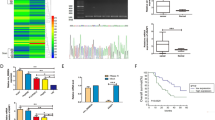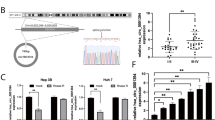Abstract
Hundreds of circular RNAs (circRNAs) have been identified as key regulators in biological processes; however, only few of these circRNAs have been functionally described to participate in the development of hepatocellular carcinoma (HCC). The present study aimed to reveal the function and molecular mechanisms of circ_0124208 in HCC. Real-time quantitative PCR revealed the upregulation of circ_0124208 in HCC tissues and cells. Based on cell functional experiments, silencing circ_0124208 attenuated proliferation and migration, but boosted the apoptosis of Hep 3B and Huh7 cells in vitro. The in vivo experiment further validated the repression of tumor growth via circ_0124208 knockdown. RNA immunoprecipitation and dual-luciferase reporter assays showed that circ_0124208 sponged miR-338-3p and reduced its expression. miR-338-3p inhibition was found to partially reverse the tumor-suppressive effects caused by circ_0124208 in Hep 3B and Huh7 cells. Furthermore, miR-338-3p directly targeted laminin subunit gamma 1 (LAMC1). The malignancy of Hep 3B and Huh7 cell was decreased by LAMC1 knockdown, and this effect was mitigated by miR-338-3p suppression. Overall, circ_0124208 was demonstrated for the first time to play a crucial role as an oncogene in HCC, implying that it could be a useful biomarker for HCC diagnosis. Furthermore, the circ_0124208/miR-338-3p/LAMC1 axis can be used as a potential therapeutic target for HCC treatment.
Graphical abstract








Similar content being viewed by others
Data Availability
This article contains all of the data that were created or examined during this investigation.
References
Rebouissou, S., & Nault, J. C. (2020). Advances in molecular classification and precision oncology in hepatocellular carcinoma. Journal of Hepatology, 72, 215–229.
Yang, J. D., & Heimbach, J. K. (2020). New advances in the diagnosis and management of hepatocellular carcinoma. BMJ (Clinical Research ed.), 371, m3544.
Yang, J. D., Hainaut, P., Gores, G. J., Amadou, A., Plymoth, A., & Roberts, L. R. (2019). A global view of hepatocellular carcinoma: Trends, risk, prevention and management. Nature Reviews. Gastroenterology & Hepatology, 16, 589–604.
Kristensen, L. S., Andersen, M. S., Stagsted, L. V. W., Ebbesen, K. K., Hansen, T. B., & Kjems, J. (2019). The biogenesis, biology and characterization of circular RNAs. Nature Reviews. Genetics, 20, 675–691.
Chen, L. L. (2020). The expanding regulatory mechanisms and cellular functions of circular RNAs. Nature Reviews. Molecular Cell Biology, 21, 475–490.
Szabo, L., & Salzman, J. (2016). Detecting circular RNAs: Bioinformatic and experimental challenges. Nature Reviews. Genetics, 17, 679–692.
Thomson, D. W., & Dinger, M. E. (2016). Endogenous microRNA sponges: Evidence and controversy. Nature Reviews. Genetics, 17, 272–283.
Kristensen, L. S., Jakobsen, T., Hager, H., & Kjems, J. (2022). The emerging roles of circRNAs in cancer and oncology. Nature Reviews. Clinical Oncology, 19, 188–206.
Shen, H., Liu, B., Xu, J., Zhang, B., Wang, Y., Shi, L., & Cai, X. (2021). Circular RNAs: Characteristics, biogenesis, mechanisms and functions in liver cancer. Journal of Hematology & Oncology, 14, 134.
Li, Y., Ji, M., Huang, X., Yang, F., Yang, Z., & Shen, L. (2022). CircRNA_0040705 promotes the progression of hepatocellular carcinoma. IUBMB Life, 74, 408–418.
Chen, S., Cao, X., Zhang, J., Wu, W., Zhang, B., & Zhao, F. (2022). circVAMP3 drives CAPRIN1 phase separation and inhibits hepatocellular carcinoma by suppressing c-Myc translation. Advanced Science (Weinheim, Baden-Wurttemberg, Germany), 9, e2103817.
Liu, D., Liu, W., Chen, X., Yin, J., Ma, L., Liu, M., Zhou, X., Xian, L., Li, P., Tan, X., Zhao, J., Liao, Y., & Cao, G. (2022). circKCNN2 suppresses the recurrence of hepatocellular carcinoma at least partially via regulating miR-520c-3p/methyl-DNA-binding domain protein 2 axis. Clinical and Translational Medicine, 12, e662.
Cai, Y., & Jia, Y. (2022). Circular RNA SOX5 promotes the proliferation and inhibits the apoptosis of the hepatocellular carcinoma cells by targeting miR-502-5p/synoviolin 1 axis. Bioengineered, 13, 3362–3370.
Wang, M., Yu, F., & Li, P. (2018). Circular RNAs: Characteristics, function and clinical significance in hepatocellular carcinoma. Cancers, 10, 258.
Wang, Z., Yang, Y., Xiong, W., Zhou, R., Song, N., Liu, L., & Qian, J. (2020). Corrigendum to “Dexmedetomidine protects H9C2 against hypoxia/reoxygenation injury through miR-208b-3p/Med13/Wnt signaling pathway axis” [Biomed Pharmacother 125 (2020) 110001]. Biomedicine & Pharmacotherapy = Biomedecine & Pharmacotherapie, 130, 110841.
Huang, X. Y., Huang, Z. L., Huang, J., Xu, B., Huang, X. Y., Xu, Y. H., Zhou, J., & Tang, Z. Y. (2020). Exosomal circRNA-100338 promotes hepatocellular carcinoma metastasis via enhancing invasiveness and angiogenesis. Journal of Experimental & Clinical Cancer Research : CR, 39, 20.
Liu, Z., Yu, Y., Huang, Z., Kong, Y., Hu, X., Xiao, W., Quan, J., & Fan, X. (2019). CircRNA-5692 inhibits the progression of hepatocellular carcinoma by sponging miR-328-5p to enhance DAB2IP expression. Cell Death & Disease, 10, 900.
Chen, L., & Shan, G. (2021). CircRNA in cancer: Fundamental mechanism and clinical potential. Cancer Letters, 505, 49–57.
Han, T. S., Hur, K., Cho, H. S., & Ban, H. S. (2020). Epigenetic associations between lncRNA/circRNA and miRNA in hepatocellular carcinoma. Cancers, 12, 2622.
Luo, Z., Mao, X., & Cui, W. (2019). Circular RNA expression and circPTPRM promotes proliferation and migration in hepatocellular carcinoma. Medical Oncology (Northwood, London, England), 36, 86.
Wu, F., Sun, G., Zheng, W., Tang, W., Cheng, Y., Wu, L., Li, X., Tao, J., Ma, S., & Cao, H. (2021). circCORO1C promotes the proliferation and metastasis of hepatocellular carcinoma by enhancing the expression of PD-L1 through NF-κB pathway. Journal of Clinical Laboratory Analysis, 35, e24003.
Huang, G., Liang, M., Liu, H., Huang, J., Li, P., Wang, C., Zhang, Y., Lin, Y., & Jiang, X. (2020). CircRNA hsa_circRNA_104348 promotes hepatocellular carcinoma progression through modulating miR-187-3p/RTKN2 axis and activating Wnt/β-catenin pathway. Cell Death & Disease, 11, 1065.
Cedric, B. C., Souraka, T. D. M., Feng, Y. L., Kisembo, P., & Tu, J. C. (2020). CircRNA ZFR stimulates the proliferation of hepatocellular carcinoma through upregulating MAP2K1. European Review for Medical and Pharmacological Sciences, 24, 9924–9931.
Luan, X., & Wang, Y. (2018). LncRNA XLOC_006390 facilitates cervical cancer tumorigenesis and metastasis as a ceRNA against miR-331-3p and miR-338-3p. Journal of Gynecologic Oncology, 29, e95.
Xu, K., Zhan, Y., Yuan, Z., Qiu, Y., Wang, H., Fan, G., Wang, J., Li, W., Cao, Y., Shen, X., Zhang, J., Liang, X., & Yin, P. (2019). Hypoxia induces drug resistance in colorectal cancer through the HIF-1α/miR-338-5p/IL-6 feedback loop. Molecular Therapy, 27, 1810–1824.
van der Sijde, F., Vietsch, E. E., Mustafa, D. A. M., Li, Y., & van Eijck, C. H. J. (2020). Serum miR-338–3p and miR-199b-5p are associated with the absolute neutrophil count in patients with resectable pancreatic cancer. Clinica Chimica Acta, 505, 183–189.
He, W., & Lu, J. (2020). MiR-338 regulates NFATc1 expression and inhibits the proliferation and epithelial-mesenchymal transition of human non-small-cell lung cancer cells. Molecular Genetics & Genomic Medicine, 8, e1091.
Li, Q., Pan, X., Zhu, D., Deng, Z., Jiang, R., & Wang, X. (2019). Circular RNA MAT2B promotes glycolysis and malignancy of hepatocellular carcinoma through the miR-338–3p/PKM2 axis under hypoxic stress. Hepatology (Baltimore, MD), 70, 1298–1316.
Wan, L., Han, Q., Zhu, B., Kong, Z., & Feng, E. (2022). Circ-TFF1 facilitates breast cancer development via regulation of miR-338-3p/FGFR1 Axis. Biochemical Genetics, 60, 315–335.
Chen, Z. Q., Yuan, T., Jiang, H., Yang, Y. Y., Wang, L., Fu, R. M., Luo, S. Q., Zhang, T., Wu, Z. Y., & Wen, K. M. (2021). MicroRNA-8063 targets heterogeneous nuclear ribonucleoprotein AB to inhibit the self-renewal of colorectal cancer stem cells via the Wnt/β-catenin pathway. Oncology Reports. https://doi.org/10.3892/or.2021.8170
Chen, J. S., Liang, L. L., Xu, H. X., Chen, F., Shen, S. L., Chen, W., Chen, L. Z., Su, Q., Zhang, L. J., Bi, J., Zeng, W. T., Li, W., Ma, N., & Huang, X. H. (2017). miR-338-3p inhibits epithelial-mesenchymal transition and metastasis in hepatocellular carcinoma cells. Oncotarget, 8, 71418–71429.
Domogatskaya, A., Rodin, S., & Tryggvason, K. (2012). Functional diversity of laminins. Annual Review of Cell and Developmental Biology, 28, 523–553.
Kunitomi, H., Kobayashi, Y., Wu, R. C., Takeda, T., Tominaga, E., Banno, K., & Aoki, D. (2020). LAMC1 is a prognostic factor and a potential therapeutic target in endometrial cancer. Journal of Gynecologic Oncology, 31, e11.
Ke, H. L., Ke, R. H., Li, B., Wang, X. H., Wang, Y. N., & Wang, X. Q. (2013). Association between laminin γ1 expression and meningioma grade, recurrence, and progression-free survival. Acta Neurochirurgica, 155, 165–171.
Zu, C., Liu, T., & Zhang, G. (2016). MicroRNA-506 inhibits malignancy of colorectal carcinoma cells by targeting LAMC1. Annals of Clinical and Laboratory Science, 46, 666–674.
Zhang, Y., Xi, S., Chen, J., Zhou, D., Gao, H., Zhou, Z., Xu, L., & Chen, M. (2017). Overexpression of LAMC1 predicts poor prognosis and enhances tumor cell invasion and migration in hepatocellular carcinoma. Journal of Cancer, 8, 2992–3000.
Andrews, M. C., Cursons, J., Hurley, D. G., Anaka, M., Cebon, J. S., Behren, A., & Crampin, E. J. (2016). Systems analysis identifies miR-29b regulation of invasiveness in melanoma. Molecular Cancer, 15, 72.
Wang, Y. Q., Huang, G., Chen, J., Cao, H., & Xu, W. T. (2021). LncRNA SNHG6 promotes breast cancer progression and epithelial-mesenchymal transition via miR-543/LAMC1 axis. Breast Cancer Research and Treatment, 188, 1–14.
Fang, L., Che, Y., Zhang, C., Huang, J., Lei, Y., Lu, Z., Sun, N., & He, J. (2021). LAMC1 upregulation via TGFβ induces inflammatory cancer-associated fibroblasts in esophageal squamous cell carcinoma via NF-κB-CXCL1-STAT3. Molecular Oncology, 15, 3125–3146.
Ye, G., Qin, Y., Wang, S., Pan, D., Xu, S., Wu, C., Wang, X., Wang, J., Ye, H., & Shen, H. (2019). Lamc1 promotes the Warburg effect in hepatocellular carcinoma cells by regulating PKM2 expression through AKT pathway. Cancer Biology & Therapy, 20, 711–719.
Yang, Z. P., Ma, H. S., Wang, S. S., Wang, L., & Liu, T. (2017). LAMC1 mRNA promotes malignancy of hepatocellular carcinoma cells by competing for MicroRNA-124 binding with CD151. IUBMB Life, 69, 595–605.
Li, Z., Zhang, J., Jiang, Y., Bao, J., & Li, D. (2021). Circular ribonucleic acid nei-like deoxyribonucleic acid glycosylase 3 governs the microribonucleic acid -3150b-3p/laminin subunit gamma 1 network to partially promote the development of hepatocellular carcinoma. Hepatology Research, 51, 702–714.
Mou, Y., & Sun, Q. (2022). The long non-coding RNA ASMTL-AS1 promotes hepatocellular carcinoma progression by sponging miR-1343-3p that suppresses LAMC1 (laminin subunit gamma 1). Bioengineered, 13, 746–758.
Acknowledgements
None.
Author information
Authors and Affiliations
Contributions
The research was created and is being led by JYC. ZL and YZ developed the approach and carried out the research. HC discover the needed resources. Analyzing the data and performing the tests were performed by LX. The paper was written by ZL and YZ. The manuscript was read and modified by JYC, HC, and LX. All authors have reviewed and approved the manuscript.
Corresponding author
Ethics declarations
Conflict of interest
The author(s) declare(s) that there is no conflict of interest regarding the publication of this article.
Ethical Approval
The Affiliated Hospital of North Sichuan Medical College's Ethics Committee gave its consent to the current study (Nanchong, China). The handling of clinical tissue samples complies with the values set out in the Declaration of Helsinki. Each patient signed an informed consent form in writing. The Affiliated Hospital of North Sichuan Medical College's Ethics Committee approved this animal experiment, which was carried out in compliance with the ARRIVE criteria.
Consent to participate
Each patient completed an informed consent form in writing.
Publication consent
The participants consented to their names being published.
Additional information
Publisher's Note
Springer Nature remains neutral with regard to jurisdictional claims in published maps and institutional affiliations.
Rights and permissions
Springer Nature or its licensor (e.g. a society or other partner) holds exclusive rights to this article under a publishing agreement with the author(s) or other rightsholder(s); author self-archiving of the accepted manuscript version of this article is solely governed by the terms of such publishing agreement and applicable law.
About this article
Cite this article
Chen, J., Liu, Z., Zhong, Y. et al. Circ_0124208 Promotes the Progression of Hepatocellular Carcinoma by Regulating the miR-338-3p/LAMC1 Axis. Mol Biotechnol 65, 1750–1763 (2023). https://doi.org/10.1007/s12033-023-00686-2
Received:
Accepted:
Published:
Issue Date:
DOI: https://doi.org/10.1007/s12033-023-00686-2




